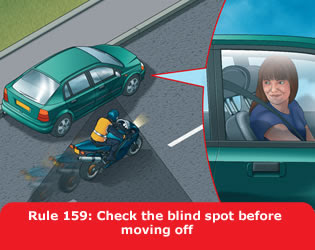 Moving away from the kerb is a time where there is risk of you missing smaller vehicles, such as motorbikes and cyclists, in your blind spot.
Moving away from the kerb is a time where there is risk of you missing smaller vehicles, such as motorbikes and cyclists, in your blind spot.
It’s important that you look in your rear-view mirror, your side mirror, and over your shoulder in your blind spot to make sure that you know what is coming up the road.
Properly adjusted mirrors will minimise your blind spot. As you look from the driver’s seat, your mirrors should be adjusted so that you can only just see the side of your vehicle. This means that your mirror is angled as far out as possible while still retaining the reference point of the side of your vehicle.
Your rear view mirror should be adjusted so that your view of the rear window is centralised in the mirror. This also allows you to see back further up each lane behind you.
Your height influences how bad your blind spot is. The shorter you are the more extreme your blind spot is because the wing mirror can’t provide as beneficial an angle. However, the shorter you are, the less obstructed your sideways view is by the B pillar (the front door pillar), so there is some trade-off. If you are taller, be aware that sitting further back can cause the B pillar to be more obstructive to your view over your shoulder.
If you have convex mirrors on your wing mirrors they can provide additional blind spot coverage, although tend to distort the perception of distance even more.
Be sure to indicate your intentions for at least three seconds before moving off. This gives other motorists and cyclists adequate time to see what you are doing.
As you pull into traffic, accelerate swiftly to match the speed of the traffic. Ensure you are also looking forwards as you move away – the road conditions can change ahead, and you need to pay attention to what’s in front of you as you move away.
If you are pulling out of a tight car parking space, manoeuvre your vehicle so that you can exit quickly when required. Other vehicles should be able to anticipate what you are doing, particularly as you will be indicating, but don’t assume that they will stop for you.
For motorcyclists
The final check you should do before moving away from the kerb is to look over your shoulder to check there are no vehicles or pedestrians approaching.
Rule 159 of the Highway Code states:
Before moving off you should
- use all mirrors to check the road is clear
- look round to check the blind spots (the areas you are unable to see in the mirrors)
- signal if necessary before moving out
- look round for a final check.
Move off only when it is safe to do so.
